Battles of the Somme
The Great War Arrives in Picardy, September 1914
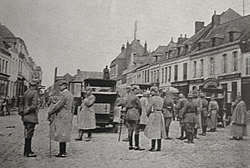
|
By 22nd September 1914, following the First Battle of the Marne (6th – 12th September 1914) and the First Battle of the Aisne (12th – 21st September 1914), the French and German armies began fighting a series of battles side-stepping one another through northern France in an attempt to outflank the other. These outflanking manoeuvres would take them in a north-westerly direction from the Aisne region towards the French coast. This period of fighting became known as “The Race to the Sea”. When the fighting of the First World War arrived in the Somme and Picardy region in September 1914 the British Expeditionary Force was not involved in the first battles of the Somme at that time.
Battles of the Somme, 1914
- First Battle of Picardy
22-Sep-1914—
26-Sep-1914
German soldiers in Thiepval village, incorporated in the new defensive Front Line on the Somme battlefield. From October 1914 the cellars were used for shelter, billets and headquarters. Trenches were dug in and around the château and the village. This trench, seen on the left side of the road, was called “Schwabengraben”. (2 119) 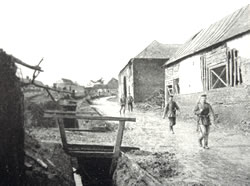
By 23rd September the German Sixth Army had arrived at St. Quentin and Péronne on the right wing of the German forces in the field, having been moved by rail from its fighting front in Lorraine a few days before.
At this time the French Tenth Army moved to the area of Amiens. From 25th September the French Army started to push in an easterly direction, engaging the Germans, trying to push them eastwards and turn the German right flank.
On the right wing of the German Sixth Army two Bavarian Corps were in action south of the Somme river at Foucaucourt-en-Santerre on 24th September. The objective was to try to push the French Army in a westerly direction towards Amiens and to swing around the French left flank. The Bavarian Corps moved further north to the area north of Péronne and east of Albert on 25th September, capturing the ground immediately north of the Somme river between the villages of Fricourt, Mametz, Montauban and Maricourt.
- First Battle of Albert
25-Sep-1914—
29-Sep-1914
While the Bavarians of the German Sixth Army were fighting the French east of Albert, the XIV (Württemberger) Reserve Corps, consisting of two divisions, was on its way from the German Seventh Army in Alsace, to move into position on the right flank of the two Bavarian Corps. The XIV Reserve Corps, consisting of two divisions and approximately 24,000 men, travelled 250 miles from Alsace by rail to Cambrai. There the two divisions detrained and marched west along the road from Cambrai to Bapaume.
On 27th September 1914 the German XIV (Württemberger) Reserve Corps advanced from Bapaume down both sides of the Roman road from Bapaume to Albert. They chased away the French Territorial units in the direction of Albert. The French put up a stubborn fight to protect Albert.
After a number of fierce battles lasting into October and November, in which the Bavarians of the German Sixth Army suffered heavy casualties, the German troops were ordered to hold their positions. In mid October the German Second Army was moved into the St. Quentin Somme battle sector and the German Sixth Army moved further north to cover the ground north of Arras in what was to become the Lille – Artois battle sector.
The German Army “Digs In”
Disappointed at having to stop the advance, the divisions north of the Somme river selected good positions on high ground on which to set up a line of defence with commanding views over the enemy's lines.
The defensive line north of the Somme river initially consisted of short trench sections and fox-holes, incorporating villages and hamlets in or behind the line, including Gommecourt, Serre, Beaumont Hamel, Thiepval, La Boisselle, Fricourt, Mametz and Montauban.
The Somme Battlefield, 1915
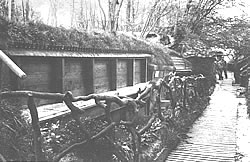
|
During 1915 the German Second Army carried out an intensive programme of construction on its Front Line and Second Line from its northern right flank at Monchy-au-Bois, south across the Ancre river valley and over the gently rolling chalk hills to the Somme river.
From August 1915 the British Third Army, commanded by General Sir Edmund Allenby, began to take over a sector of the Front Line north of the river Somme from the French Army. In December 1915 the new British front stretched from Ransart to Curlu on the Somme river. At this time the British Third Army was sandwiched between the French Tenth Army holding 20 miles of Front Line in the Arras sector and the French Sixth Army holding the Front Line south of the Somme river.
The Somme sector remained quiet over the winter of 1915/1916. The German troops busied themselves securing their defences. On both sides of the wire the troops carried on the daily routines of trench life and training.
Battles of the Somme, 1916
- Battles of the Somme
01-Jul-1916 —
18-Nov-1916
- U Day (24th June)
- V Day (25th June)
- W Day (26th June)
- X Day (27th June)
- Y Day (28th June)
- Z Day (29th June)
- U Day (24th June)
- V Day (25th June)
- W Day (26th June)
- X Day (27th June)
- Y1 Day (28th June)
- Y2 Day (29th June)
- Y Day (29th June)
- Z Day (1st July)
- Battle of Albert
01-Jul-1916—
13-Jul-1916
- Subsidiary Attack: Gommecourt Salient
01-Jul-1916
- At 07.20 hours, ten minutes before Zero Hour, a huge mine was detonated under Hawthorn Redoubt in the VIII Corps sector at Beaumont Hamel. The position was a German strongpoint in the German line on the crest of Hawthorn Ridge. This was the only mine to be blown under the German positions north of the Ancre river. The agreement to go ahead with detonation a full ten minutes before the infantry attack at Zero Hour, and the fact that the heavy artillery was timed to lift off the German front line at the same time of ten minutes before Zero Hour, gave the German troops sheltering in their dugouts and bunkers forewarning that the British attack was imminent. The explosion of the mine was filmed by the British Offical War Cameraman Lieutenant Geoffrey Malins.
- At 07.27 hours two mines were exploded north of Carnoy on the XIII Corps front.
- At 07.28 three mines were detonated on the XV Corps front under the German position known as The Tambour to the west of Fricourt. On this same corps front a mine was blown at Bulgar Point, a heavily wired German strongpoint south-east of Mametz, and four small mines were detonated under the German line at a place called Hidden Wood between Fricourt and Mametz.
- Also at 07.28 hours two very large mines were detonated on the III Corps front on the both sides of the Albert-Bapaume road. The mine on the northern side of the road was at a position called Y Sap. It contained 40,600 lbs of ammanol and was at the end of a 1,030 feet long gallery, the longest ever driven into chalk during the First World War. The mine on the southern side of the road, near La Boisselle, was at a position known as Lochnagar. It contained 60,000 lbs of ammonal split between two charges at a depth of 52 feet underground.
- Capture of Montauban on 1st July by 30th Division
- Capture of Mametz by 7th Division
- Capture of Fricourt by 17th Division
- Capture of Contalmaison by 23rd Division
- Capture of La Boisselle by 19th Division
A Franco-British Offensive
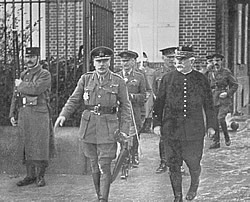
|
Ten days after General Sir Douglas Haig was appointed as the Commander-in-Chief of the British Expeditionary Force (B.E.F.) he attended a conference at Chantilly with the President of France, Monsieur Raymond Pointcaré, the French Prime Minister, Monsieur Aristide Briand, the French Minister of War, General Joseph Gallieni, three French Army commanders and the French Commander-in-Chief, General Joffre. The following day, 30th December, General Haig received a letter from General Joffre, pressing for the replacement of the French Tenth Army at Arras by the British. Also, in the letter, General Joffre proposed the study of a great combined Franco-British offensive astride the Somme river on a sixty mile front from Lassigny (30 miles south-east of Amiens) to Arras. This was the beginning of a series of discussions about the British involvement in what was eventually to commit the British Expeditionary Force to a large-scale offensive on the Somme battlefield in the summer of 1916.
Initially General Joffre proposed that the British should make preparatory attacks north of the Somme river to wear down the Germans in April and May, several weeks before a main offensive by French forces, who would carry out the breakthrough. General Haig was not in agreement with this suggestion. On 14thFebruary 1916 it was agreed by General Haig and General Joffre that a combined offensive should take place astride the Somme river on 1st July 1916. It would be preceded by an attack somewhere in the sector between La Bassée and Ypres to draw German attention away from the main offensive on the Somme.
With regard to the origins of the proposal for a British attack north of the Somme river, it was not borne out of a far-sighted strategic objective. Even if a swift breakthrough could be achieved in the sector, the Allies would not find themselves in a position to cause significant disruption to crucial German routes of communication and supply, which would have given a strategic purpose to this offensive. The main German rail routes were as far away from this front as Mézières and Sedan in France and Brussels in Belgium. A breakthrough and advance north and south of the Somme would achieve the capture of enemy-held territory, but in this sector would likely only create a situation where the Allies were holding a bulge in the line, thereby increasing the need for additional manpower to hold a longer length of line. Added to this the distinct disadvantage for the British attacking force would be the fact that the Germans had spent the past year and a half building a secure defensive first line, intermediate and second position on top of and underneath the rolling chalk hills of Picardy.
With this in mind, General Haig wanted to continue with proposals he had for an attack in the northern part of the Western Front in the British sector between La Bassée and Ypres. Not just as a preparatory diversion, but there could be an opportinity to break through the German line here, cut off the northern end of the German front in Flanders, advance into the rear of the German force in Artois and roll up the German line to the south. General Joffre was not prepared to commit to this idea at this time, and only said that it might form part of a final stage of the offensive operations in Picardy. General Haig, nevertheless, had already asked General Plumer, commander of the British Second Army in Flanders, to examine schemes for offensives at the Forest of Houthulst and Messines-Wytschaete Ridge in the Ypres sector, and Lille in the Artois-French Flanders sector. In April 1916 General Haig did give the go ahead to prepare for the capture of the Messines-Wytschaete Ridge. The British Second Army in the Ypres Salient was prepared for this offensive to go ahead, involving the detonation of 22 large mines, until as late as 7th June July 1916. At that time it was postponed and went ahead with success on 7th June 1917 as the Battle of Messines.
French Tenth Army Leaves Arras Sector
Exactly one week after the decision to make the Allied Somme offensive the German Army launched an attack on the French front at Verdun on 21st February. As requested by the French Commander-in-Chief, General Joffre, and in view of the new pressure put on French forces defending Verdun, the British Army made preparations to take over the 20 miles of Front Line in the Arras sector held at that time by the French Tenth Army. The take-over was carried out from mid March 1916.
British Fourth Army Formed
On 1st March the British Fourth Army was formed with General Sir Henry Rawlinson as its commander. Headquarters was established in a chateau at Querrieu on the Albert-Amiens road. The Front Line held by Fourth Army was from Fonquevillers in the north to the Somme river. At the beginning of June the French Sixth Army took over a short section of British-held Front Line north of the Somme river as far as the west of Maricourt village. This was done to remove a potential weakness in the Allied Front, whereby the Somme river was forming the boundary between the two Allied forces and General Joffre was concerned that a gap might be forced here by the Germans between the British and French as they were carring out the forthcoming offensive.
Infantry for the Attack
As the plan for the offensive between Serre and Maricourt developed during April, May and June, there were five Corps committed in the field by Fourth Army. 13 infantry divisions were to launch the attack from the front line. Four were to be held in reserve behind the forward areas.
The Third Army would commit two infantry divisions for a subsidiary attack at Gommecourt on the Fourth Army's left flank. On the right flank of the Fourth Army, two French infantry divisions would attack north of the Somme river. On the other side of the wire, 5 German front line divisions were in position to defend their Front Line, with 4 in reserve and/or at rest.
Preparations for the Offensive
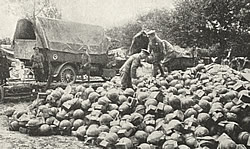
|
From the early spring of 1916 into June the Somme battlefield sector behind the British and French lines was the scene of a huge build-up of troops, artillery and equipment in preparation for the large-scale Allied offensive on the German defensive line. On 3rd June General Joffre confirmed to the British Commander-in-Chief, General Haig, that the date for the joint offensive would be set with the infantry advance to commence on Saturday 1st July. However, the French attack by French Sixth Army south of the river Somme, which had originally been proposed as an advance on a wide front was, in view of the reduction of French forces having been redeployed to the Verdun sector, now only going be an attack to support the British and with more limited objectives than previously proposed.
Following developments in the course of the Battle of Verdun by mid June there was discussion about bringing the date of the Somme offensive forward, and 25th June was agreed to, with 29th June as the latest date to make the attack. As it happened, the date was moved to 29th June. But on 28th June the weather was very wet, causing trenches and gun positions to become waterlogged. The attack was postponed until 1st July. It continued to rain on the night of 29th/30th, but the morning of Saturday 1st July dawned as a dry day with a cloudless sky, with a mist lying in the river Somme and river Ancre valleys, and the prospect of a warm, sunny day.
Preparatory Bombardment
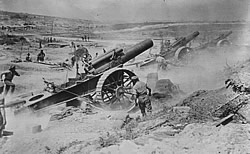
|
The artillery programme issued on 5th June was for an preparatory bombardment prior to the start of the infantry offensive to last for five days from 24th to 28th June inclusive. Z Day (Zero Day) was at that time scheduled for the infantry attack to take place on 29th June The days leading up to the battle would be:
The plan for the British artillery bombardment was as follows: the first two days was to be devoted to wire-cutting and registration of the shelling, the next three days would focus on destroying the German defences and smashing the enemy's barbed wire. For this bombardment the British Fourth Army would deploy over 1,400 heavy guns and field guns, over 100 French field guns and howitzers, plus over 300 trench mortars.
Starting on U Day, 24th June, the intensity of this artillery bombardment had not been witnessed before on this battlefront. The intention was to wear down the morale and nerves of the German defenders, cut through the German barbed wire defences and smash their Front Line trenches and rear supply routes. As a result of the postponement of the infantry attack until 1st July, there were two additional days of preparatory artillery bombardment. These were named Y1 for 28th and Y2 for 29th June. Y Day moved to 30th June and Z Day to 1st July.
The Troops Prepare for the Battle
Final preparations of training and planning were made by the British infantry during the days of the preparatory bombardment. On 30th June messages of encouragement were sent to the men by their commanders. Field services were held in the rear areas by the padres and chaplains. Some units held parades with bands playing. Equipment was cleaned and checked. Letters were written. Each man collected his ammunition. Kit to be carried into battle was handed out. The troops fell in to their units and prepared for the march that night into the Assembly Trenches in the forward area. Between 02.00 hours and 05.15 hours thousands of British troops made their way on a moonless, but clear night along pre-prepared routes to the forward lines to be in position and ready for Zero Hour at 07.30 on 1st July.
Raids and Patrols
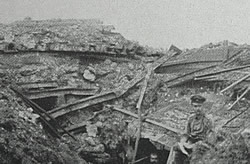
|
During the night of 30th June/1st July patrols were made into the enemy Front Line and No Mans Land. Raids were carried out so that the enemy would not be alerted to any different activity compared to that carried out on the preceeding nights. Patrols examined the state of the enemy's barbed wire defences. Reports about the wire were varied and at times conflicting. Generally it appeared from these reports that the wire had been better cut on the right of the Fourth Army front, south of the Albert-Bapaume road, than on the left front. Nevertheless, it was clear that it had not been completely destroyed. Some of the gaps which had been cut had been filled in by the Germans. In addition to this the patrol reports also stated that despite the seven day preparatory bombardment the German defensive line was strongly held and that German machine guns were still active.
Bombardment from 06.25 Hours
For just over one hour before the infantry attack was due to start at Zero Hour 07.30 the troops, packed together in the forward trenches, sat through a deafening roar of British and French guns. Shells screamed over their heads into the German forward trenches. At 07.20 the heavy guns lifted off the German Front Line. At 07.22 Stokes Mortars started up a hurricane bombardment onto the German Front Line of 30 rounds a minute.
Mines Exploded under German Positions
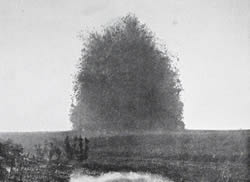
|
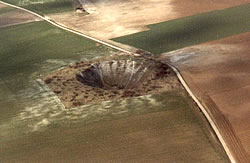
|
Infantry Advance
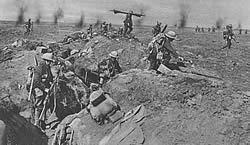
|
In some parts of the British line troops had crawled out in front of the Front Line trench before Zero Hour. At Zero Hour 07.30 whistles blew all along the British Front Line north of the Somme river. Tens of thousands of British troops clambered over the parapet into No Mans Land, making for the German Front Line.
The British Official History records the moment:
“Under a cloudless blue sky which gave full promise of the hot mid-summer day which was ahead, wave after wave of British infantry rose and, with bayontets glistening, moved forward into a blanket of smoke and mist as the barrage lifted from the enemy's front trench. Almost simultaneously the German gunners ceased their counter-battery work and concentrated their fire upon the assault.” (10)
The tragedy of the day unfolded as thousands of British troops were cut down and wounded or killed, many never even crossed No Mans Land to reach the German wire.
At the end of the first day of the battle the Germans had successfully defended their positions more or less in tact north and south of the Albert-Bapaume road from between the villages of Gommecourt and Fricourt. However, to the east of Mametz village the British 18th and 30th Divisions of XIII Corps did make a successful breakthrough beyond the German Front Line, reaching their objective by the end of the day.
Heavy Casualties
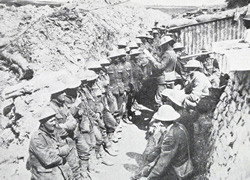
|
1st July was a tragic day for the British Army. There were some 60,000 casualties by the end of that day, 20,000 of whom were fatalities. Although the German regiments record relatively few casualties defending their line in the northern part of the battlefield two of their regiments in the south sector, where the British had successfully made a breakthrough, were decimated, each of them losing several hundred men as wounded, killed and taken prisoner.
Tactical Incidents in the Battle of Albert
In the days that followed 1st July until 13th the following ground was captured by British forces:
Battles continued in this sector into the following weeks as the British tried to break the German defence. The names of villages and woods on the Somme battlefields have become synonymous with the desperate fighting and tragic loss of both the British and German Armies during the four and a half months of these battles: Gommecourt, Serre, Beaumont Hamel, Thiepval, Ovillers, La Boisselle, Courcelette, Fricourt, Contalmaison, Mametz, Montauban, Bazentin, Longueval, Delville Wood, Martinpuich, High Wood, Flers.
- Battle of Bazentin
14-Jul-1916 —
17-Jul-1916
-
- Subsidiary action: Attack at Fromelles (on Aubers Ridge, Artois)
19-Jul-1916
- Subsequent action:
Attacks at High Wood
20-Jul-1916 —
25-Jul-1916
- Subsidiary action: Attack at Fromelles (on Aubers Ridge, Artois)
- Battle of Delville Wood
15-Jul-1916 —
03-Sep-1916
- Battle of Pozières
23-Jul-1916 —
03-Sep-1916
- Battle of Guillemont
03-Sep-1916—
06-Sep-1916
- Battle of Ginchy
09-Sep-1916
- Battle of Flers-Courcelette
15-Sep-1916—
22-Sep-1916
- Battle of Morval
25-Sep-1916—
28-Sep-1916
- Battle of Thiepval
26-Sep-1916—
28-Sep-1916
- Battle of Le Transloy
01-Oct-1916 —
18-Oct-1916
- Battle of the Ancre Heights
01-Oct-1916—
11-Nov-1916
- Battle of the Ancre, 1916
13-Nov-1916—
18-Nov-1916
The Battle of the Somme finally drew to a close as the winter weather worsened. It officially ended on 18th November 1916.
Battles of the Somme, 1918
- First Battles of the Somme, 1918 (Second Battle of Picardy)
21-Mar-1918—
05-Apr-1918
Operation Michael
On 21st March 1918 the German Army launched a large-scale offensive against the Allied front on the Somme battlefield. This offensive was codenamed Operation Michael, and was the first of several attacks to be made against the Allies on the northern part of the Western Front in the spring of 1918.
- Battle of St. Quentin
21-Mar-1918—
23-Mar-1918
With 72 German divisions in positions ready to attack in three waves, thousands of infantrymen from three German Armies (17th, 2nd and 18th) left the German Front Line after a five hour artillery bombardment by over 6,600 artillery pieces. Some 3.2 million shells were destined to land on the British-held front during that first day of the attack. To the German's advantage there was fog in the Somme battlefield sector, enabling the infantry to appear in the British forward positions without being seen to leave the German trenches.
The southern part of the British front held by Fifth Army was successfully broken by the German Eighteenth Army and the left wing of Second Army. Their troops advanced through the British Battle Zone in the forward area of the Front Line. In a change to the original plan, General Ludendorff decided to reinforce the sector of the attack on Operation Michael's left wing which was reported to be making good progress.
- First Battle of Bapaume
24-Mar-1918—
25-Mar-1918
- Battle of Noyon
25-Mar-1918
- Battle of Rosières
26-Mar-1918—
27-Mar-1918
- Battle of the Avre
4-Apr-1918
- Battle of the Ancre
5-Apr-1918
Long Range Gun Fires on Paris
On 24th March the long range, 256 ton German gun called “Kaiser Wilhelmgeschütz” fired its first shells from the forest of Coucy. With a range of 75-80 miles the gun reached Paris. There were three of these huge railway mounted guns in the forest; the breech blew off when the second gun was fired. The third gun began firing towards Paris on 29th March.
Difficulties of Supply
The German advance by the three armies continued during the few days after 21st March, but gradually the troops began to tire, having been on the move without relief for four days. Added to this, the supply of food, equipment, ammunition and horse fodder became problemmatic the further the infantry advanced ahead of their supply columns. The ground over which they were advancing was cratered with shell holes, roads were badly damaged and the villages they passed through were wrecked. Ironically, the German Army had been responsible for causing deliberate damage to this area when it made a withdrawal to the Siegfriedstellung (called the Hindenberg Line by the British) in the early months of 1917. The wilful destruction included poisoning of wells.
By 29th March the Germans had captured several key Allied-held towns on the Somme battlefield: Peronne, Ham, Noyon, Roye, Montdidier, Albert and Bapaume. The loss of the latter two was especially bitter for the British, given that they had struggled through the summer of 1916 to advance to Bapaume and many thousands of lives had been lost to capture this town. Within a few days in March of 1918 the ground was once more in German hands.
On 30th March General Ludendorff issued orders that the next phase of the German offensive, Operation Georgette in Flanders, would be carried out and artillery was to begin moving from the rear of the Michael area to Flanders for the artillery preparatory bombardment. The next day, 31st March, General Ludendorff chose to rest the troops fighting in the Somme sector for a couple of days with a view to resuming the advance of Operation Michael. However, by 4th March the French Army had begun to reinforce its positions with extra reserves to hold back the German Eighteenth Army south of the Somme river. American troops were beginning to arrive on the battlefront. The British and Australian forces put up a successful defence at the village of Villers-Bretonneux against units of the German Second Army. Strong Allied counter-attacks prevented further progress by the Germans to the town of Amiens. Some German commanders now considered that Germany's last chance to strike a decisive blow against the British had passed. The shortages of reserves, ammunition and horses made it impossible to consider launching another offensive in this sector on such a large-scale. On the evening of 5th April General Ludendorff sent a message to say that Operation Michael was terminated.
Casualties
Although the Germans had gained over 1,000 square miles of Allied-held territory in a few days, the casualties suffered by the Germans is recorded as 31,000 killed, 20,000 missing and 190,000 wounded. The German offensive resulted in 160,000 Allied casualties killed or wounded and 90,000 men taken prisoner. By the end of Operation Michael the German troops were generally dispirited and disorganized.
- Actions at Villers-Bretonneux
24-04-18
- Battle of Le Hamel
04-07-18
- Battle of Amiens
08-Aug-1918—
11-Aug-1918
The Second Battles of the Somme 1918 were fought in the summer of that year, following the German spring offensive of Operation Michael. The Allied offensive of the summer opened with the Battle of Amiens on 8th August. The French Army attacked at the same time to the south of the river Somme in the Battle of Montdidier. Ten Allied divisions were involved including Australian and Canadian forces serving with the British Fourth Army. The Allied forces surprised the Germans on the first day of 8th August and made rapid progress eastwards of several miles, taking hundreds of German prisoners on the way. The significant advance recaptured much of the ground lost by the Allies in March, earlier in the year. This battle marked the end of the stalemate of trench warfare on the Western Front, the effective combination of infantry, air support and tanks. It was the beginning of several battles from August to November 1918, which became known as the Hundred Days Offensive. The Allied success of 8th August was a black day for the German Army.
- Battle of Albert
21-Aug-1918—
22-Aug-1918
The British Third Army and the United States II Corps launched the attack to recapture Albert on 21st August. The town of Albert was retaken on 22nd and the town of Bapaume was captured on 29th August.
- Second Battle of Bapaume
21-Aug-1918—
03-Sep-1918
The success of the Battle of Amiens continued with the Second Battle of Bapaume from 21st August. The British Third Army and the United States II Corps launched the attack. The town of Albert was retaken on 22nd and the town of Bapaume was captured on 29th August.
- Battle of Mont St. Quentin
31-Aug-1918—
04-Sep-1918
During the night of 30th/31st August troops of the Australian 2nd Division crossed the marshy ground and the Somme river to make their way up the slope to the high ground of Mont St. Quentin. A German-held position on this hill overlooked the town of Péronne and provided the Germans with a good vantage point over any Allied attack in daylight. Successfully taking the summit of the hill, the Australians were pushed off it again when German reserves arrived to recapture the position. The next day, however, the Australians managed to push the Germans off the hill completely and it was finally under Allied control. The town of Péronne was captured on 1st September. The Australian units involved suffered high casualties but had achieved a great success in capturing the position, resulting in the start of a German withdrawal to the east.
Related Links
Cemeteries on the Somme Battlefields
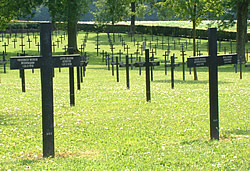
|
There are over 250 military cemeteries on the Somme battlefields for the many thousands of casualties who have identified graves. The cemeteries range in size from a few battlefield burials to cemeteries containing several thousand individuals. There are graves marked as unidentified for those whose remains were discovered, but it was not possible to identify them. In the case of the French military cemeteries and burial sites there are graves and ossuaries for the remains of French soldiers. The German military cemeteries are on land granted by the French nation for the burial of German dead, but in most cases the soldiers are buried with up to four individuals in each plot and in mass graves marked as “Kameradengraben” (Comrades Grave).
Cemeteries on the Somme BattlefieldsMonuments on the Somme Battlefields
Monuments and memorials on the Somme battlefields range from monuments dedicated to the memory of thousands of troops whose identified remains are missing, to monuments commemorating a specific military unit or an individual.
Monuments on the Somme BattlefieldsThiepval Memorial to the Missing
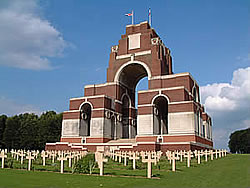
|
The Thiepval Memorial to the Missing commemorates over 72,000 soldiers of the United Kingdom and South African forces who died in the Somme sector before 20th March 1918 and have no known grave. Over 90% of those commemorated died during the 1916 Battles of the Somme between July and November 1916.
Thiepval Memorial to the MissingMuseums on the Somme Battlefields
Museums on the Somme BattlefieldsAcknowledgements
(1, 2, 7) Das Württembergische Reserve-Infanterie-Regiment Nr 119 im Weltkrieg 1914-1918, von Matthäus Gerster, Chr. Belsersche Verlagsbuchhandlung, Stuttgart, 1920.
(3) An der Somme: Erinnerungen der 12. Infanterie-Division an die Stellungskämpfe und Schlacht an der Somme, Oktober 1915 bis November 1916, Ferd. Dümmlers Verlagsbuchhandlung, Berlin, 1918.
(4, 5, 6, 8, 9, 11 GWPDA) Photographs with grateful thanks to the Great War Primary Document Archive: Photos of the Great War.
(10) History of the Great War, Military Operations, France and Belgium 1916, Sir Douglas Haig's Command to the 1st July: Battle of the Somme, compiled by Brigadier-General Sir James E Edmonds, CB, CMG, RE (Retired), psc. Macmillan and Co, Ltd., 1932, p. 315.
A Record of the Battles and Engagements of the British Armies in France and Flanders, 1914-1918, by Captain E A James. Originally published in 1924 by Gale & Polden Ltd, Aldershot. Republished in 1990 by The London Stamp Exchange Ltd.
History of the Great War, Military Operations, France and Belgium 1916, Sir Douglas Haig's Command to the 1st July: Battle of the Somme, compiled by Brigadier-General Sir James E Edmonds, CB, CMG, RE (Retired), psc. Macmillan and Co, Ltd., 1932.
